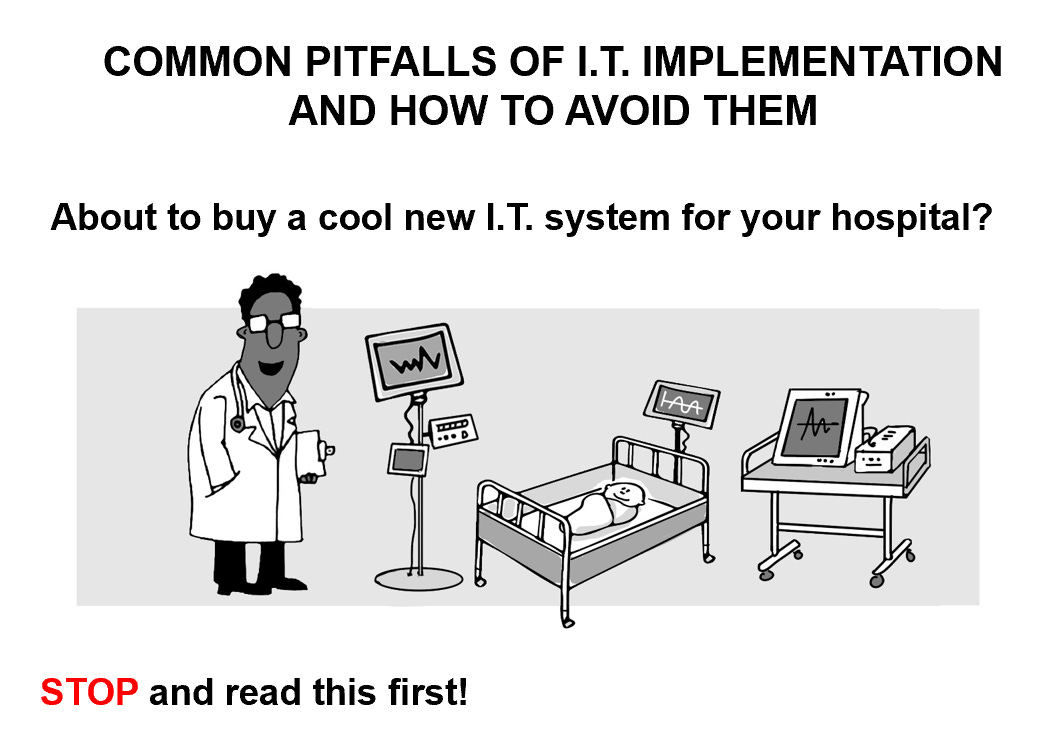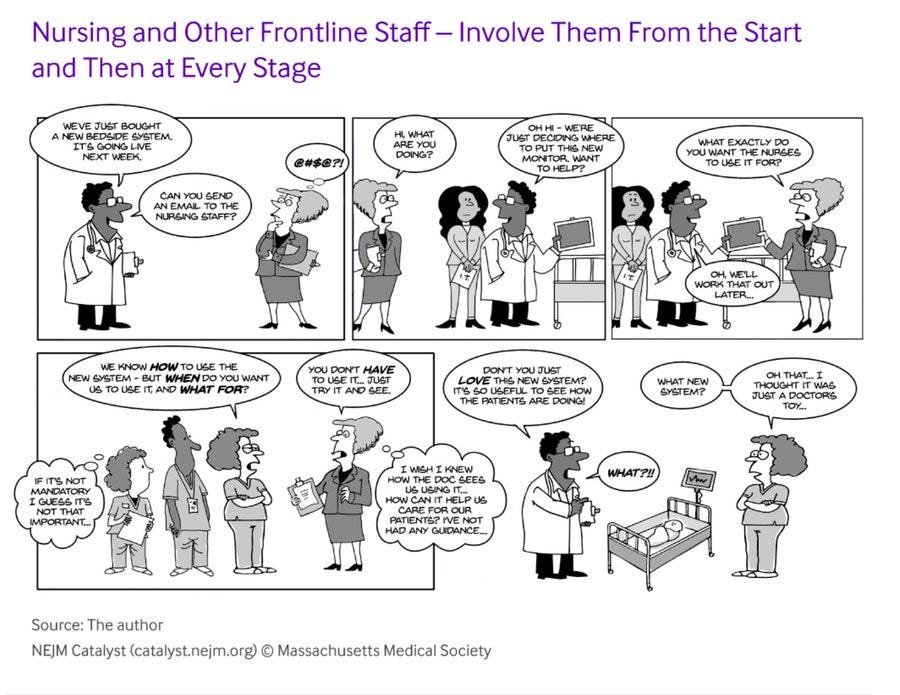How not to implement new IT systems in hospitals...
An entirely non-Covid post
A few years ago, I did a project in the US, interviewing staff across different hospitals which had all implemented the same intensive care IT system. I used the interviews to develop a simple cartoon guide on the common pitfalls of IT implementation within health care and how to avoid (some of) them.
In any sector, new IT systems are often hailed as a magic bullet which then turn out to be a dead duck. The issues highlighted in this guide apply more generally to any tech implementation in any sector. Below is a thread I wrote on it back in 2020 and a link to the full guide at the end. I’ve lightly edited it for readability. I think it is still, unfortunately, as relevant as ever!
NOTE: I’ve separated my substack into different sections - subscribers can choose to subscribe only to specific ones and unsubscribe from others. Current sections are: All about Covid; NHS by numbers (including NHS performance metrics); Misc posts; and Legacy Covid Twitter Threads.
*********
THREAD: many of us in healthcare have seen new IT systems hailed as gamechangers. Many don't live up to their promise. Often failure is at the final step of implementation - I interviewed people at 4 hospitals who all implemented the same IT system & developed these cartoons...
The hope is that they capture typical stories of what pitfalls happen in real life - and give tips for how to avoid them! The full cartoons (and a downloadable booklet) are available from NEJM Catalyst, but here are some excerpts. Quotes are from real people!
Getting to contract signing and purchase
"Because it involved IT, even tho the CMO had signed off & we had his blessing & the promised resources & the contract, then we had to go through what we call the IT gov committee. Which is not a quick process, so we had to formally present this…and that took another 6 mnths"
Key tips for avoiding these barriers!
Technical issues and practicalities
"Our [hospital] rooms are kind of small - they're small from the standpoint of where we could put the monitors - they're not in a good spot to be able to utilize them on rounds... I would say that that's part of the frustration - the location of some of the monitors is not the best place"
Involve intended users from the beginning!
"Often it's like "ta-da, we got this new thing" and it's like "oh that's [MD’s] toy…versus "okay, we're going to implement this, we're all going to own it, it's going to meaningful to everyone so what do you think about it?"
What’s the point of the system?
"I kept pressing for something I could give the nurses to say these are guidelines for using this…. [docs] didn't have a whole lot of input as to what they expected bedside nurses to use it for. And it's not that we want to ignore it ... but we also want to know how is it useful.."
The full booklet is available on my google drive, and includes more quotes, a brief explanation of how I developed it and a handy checklist. If you use it, please do acknowledge the source!









Your cartoons are spot on and very funny.
Sorry for the long response but you triggered a lot of frustration I've had over the years. I've worked in IT healthcare, it's where I started my career. I've also worked in a lot of other IT sectors and, while the issues you highlight are true in all those sectors, they are particularly painful in healthcare! What is depressing is this was the situation in the UK in 1990 - and it appears to have not improved.
I think the key thing that you highlight is that anyone who is purchasing an IT system in healthcare needs to go to their IT department first. Before it is purchased! The hospital IT department are the experts in making such systems work and integrating it with all the other systems. An IT system that does neither of these things is an expensive waste of space.
The next people they should talk to is IT governance as any system that does not meet the regs is again an expensive waste of space.
The final key thing, and in my experience this is absolutley vital but often ignored , is to engage with whoever is supposed to use the system, put the information in and use it day to day. I've seen systems put in which fail because there is nothing to help the nurses do their job, they have too much to do and piddling about with yet another new IT system is not going to win over caring for the patient.
Again, sorry this comment is so long!
As someone who experienced a full EPR install that was touted as the bees-knees, the ludicrous amount of paper document record keeping we needed to keep tabs on the fudged work-arounds and massive holes we found, just for ultrasound work loads was outrageous.
I cannot imagine just how insane it must have been for other departments. The frayed tempers were palpable.